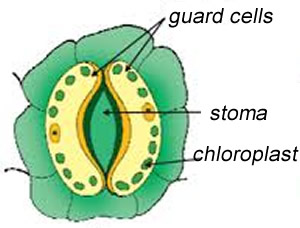A stoma is a microscopic pore present on the surface of the leaves of terrestrial plants. The size of the stoma is controlled by two cells called the guard cells. Guard cells respond to environmental conditions by filling with water and opening the stoma or loosing water and closing the stoma.
The stoma is where the plant exchanges gases with the atmosphere. Both carbon dioxide and oxygen gases move through the stomata and are used fro photosynthesis and cellular respiration, respectively. Stomata also act to transport water from the roots, through fine tubes in the trunk to the leaves and out into the atmosphere. The evaporation of water from the leaves is known as transpiration and is responsible for pulling long columns of water up the trunk.
During a drought stomata shut tightly preventing water loss and death of the plant.

1. A student observed the number of stomata on the upper and lower surface of a leaf from an outdoor plant. She noticed that stomata were mainly present on the underside of the leaf. Explain why this may be the case.
2. Consider a leaf from a desert plant and a leaf from a plant found in a tropical rainforest. Which leaf, do you think, will have the highest density of stomata on its surface? Explain why.
3. Observe the video on the right and explain, in detail, how guard cells open and close stomata?
a) What are guard cells? What is their function?
b) Explain how guard cells perform their function.
c) What part of the plant releases abcisic acid?
d) What triggers the release of abcisic acid?
e) What is the effect of abcisic acid on the stomata?
4. During a 24 hour cycle, what time of day would stomata be closed and why?
5. How are stomata integral to the transport of nutrients to the leafs?
6. Define transpiration.
7. Name the two gases that move in and out of the stomata and describe how the plant uses these gases?
8. What is the link between the number of stomata on the leaf surface and the climate in which the plant lives?
Sourced from https://www.youtube.com/watch?v=gqhTq83PrSI